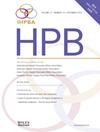高危麻醉患者的腹腔镜肝切除术一项法国全国性研究。
IF 2.4
3区 医学
Q2 GASTROENTEROLOGY & HEPATOLOGY
引用次数: 0
摘要
背景:目前缺乏评估美国麻醉医师协会身体状况(ASA-PS)评分对肝切除术(LR)后预后影响的研究。目的是评估ASA-PS评分对腹腔镜肝切除术(LLR)围手术期预后的价值。方法:回顾性分析1996年至2018年在法国29个医疗中心接受LLR治疗的患者。高危麻醉患者定义为ASA-PS评分≥3分。比较高危麻醉患者和低危麻醉患者的术后结局,包括90天死亡率、发病率和抢救失败(术后任何主要并发症后90天内死亡)。结果:纳入的3154例患者中,734例(23.3%)ASA-PS评分≥3分。ASA-PS评分≥3组90天死亡率(2.6%比0.6%)、总发病率(42.0%比33.8%)、严重发病率(11.2%比7.4%)和抢救失败率(23.2%比7.9%)较高(均p < 0.05)。在多变量分析中,ASA-PS评分≥3分是研究人群LLR后抢救失败的独立危险因素。结论:高asa患者可行LLR,死亡率和发病率较高。本文章由计算机程序翻译,如有差异,请以英文原文为准。
Laparoscopic liver resection in high-risk anesthesia patients A French nationwide study
Background
Studies evaluating the impact of the American Society of Anesthesiologists Physical status (ASA-PS) score on outcomes after liver resection (LR) are currently lacking. The aim was to evaluate the value of ASA-PS score on perioperative outcomes for laparoscopic liver resection (LLR).
Methods
This is a retrospective analysis of patients who underwent LLR from 1996 to 2018 at 29 French medical centers. High-risk anesthesia patients were defined as those with ASA-PS scores ≥3. Postoperative outcomes including 90-day mortality, morbidity and failure to rescue (death within 90 days following any major postoperative complication) were compared between high- and low-risk anesthesia patients.
Results
Of 3154 patients included, 734 (23.3 %) had ASA-PS scores ≥3. The 90-day mortality (2.6 % vs. 0.6 %), overall morbidity (42.0 % vs. 33.8 %), severe morbidity (11.2 % vs. 7.4 %) and failure to rescue (23.2 % vs. 7.9 %) rates were higher in the ASA-PS score ≥3 group (all p < 0.05). In the multivariable analysis, ASA-PS score ≥3 was an independent risk factor for failure to rescue after LLR in the study population.
Conclusion
LLR in high-ASA patients can be performed with a higher rate of mortality and morbidity.
求助全文
通过发布文献求助,成功后即可免费获取论文全文。
去求助
来源期刊

Hpb
GASTROENTEROLOGY & HEPATOLOGY-SURGERY
CiteScore
5.60
自引率
3.40%
发文量
244
审稿时长
57 days
期刊介绍:
HPB is an international forum for clinical, scientific and educational communication.
Twelve issues a year bring the reader leading articles, expert reviews, original articles, images, editorials, and reader correspondence encompassing all aspects of benign and malignant hepatobiliary disease and its management. HPB features relevant aspects of clinical and translational research and practice.
Specific areas of interest include HPB diseases encountered globally by clinical practitioners in this specialist field of gastrointestinal surgery. The journal addresses the challenges faced in the management of cancer involving the liver, biliary system and pancreas. While surgical oncology represents a large part of HPB practice, submission of manuscripts relating to liver and pancreas transplantation, the treatment of benign conditions such as acute and chronic pancreatitis, and those relating to hepatobiliary infection and inflammation are also welcomed. There will be a focus on developing a multidisciplinary approach to diagnosis and treatment with endoscopic and laparoscopic approaches, radiological interventions and surgical techniques being strongly represented. HPB welcomes submission of manuscripts in all these areas and in scientific focused research that has clear clinical relevance to HPB surgical practice.
HPB aims to help its readers - surgeons, physicians, radiologists and basic scientists - to develop their knowledge and practice. HPB will be of interest to specialists involved in the management of hepatobiliary and pancreatic disease however will also inform those working in related fields.
Abstracted and Indexed in:
MEDLINE®
EMBASE
PubMed
Science Citation Index Expanded
Academic Search (EBSCO)
HPB is owned by the International Hepato-Pancreato-Biliary Association (IHPBA) and is also the official Journal of the American Hepato-Pancreato-Biliary Association (AHPBA), the Asian-Pacific Hepato Pancreatic Biliary Association (A-PHPBA) and the European-African Hepato-Pancreatic Biliary Association (E-AHPBA).
 求助内容:
求助内容: 应助结果提醒方式:
应助结果提醒方式:


